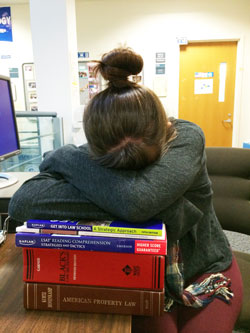The LSAT Exam is One of the Main Components that Law Schools Examine for Acceptance
 In a 2011 survey, 12,9925 students took the law school Admission Test, better known as the LSAT, every year. Although there has been a decline in the amount of students taking the LSAT each year, the LSAT attracted close to 250,000 million students a year.
In a 2011 survey, 12,9925 students took the law school Admission Test, better known as the LSAT, every year. Although there has been a decline in the amount of students taking the LSAT each year, the LSAT attracted close to 250,000 million students a year.
In 2009, 171,514 students took the LSAT and in 2010, 15,5050 students took the exam.
However, due to the recession and international competition from competing oversea law schools, the U.S. numbers have dropped substantially over the years. However, getting into law school did not always require the LSAT test. At one point, a students GPA alone was the determining factor of getting into law school until 1945 when the following schools created a board to structure what would be called the Law School Admission Test.
The idea for a test that would filter out prospective students, who could actually survive the intense curriculum of law school was developed by a Columbia law school teacher, Frank Bowles.
Harvard Law School and Yale Law School soon afterwards complied with Columbia to start administering the test to prospective students, and in 1948 the LSAT became an national test and for most students was a ticket into their choice of law school, with the assumption they achieved the desired school’s scores.
The first LSAT structure had six parts including: word classification, verbal analogies, reasoning, quantitative comparison, paragraph reading, and logical reasoning. The 1948 test had many more sections compared to the three section version that we know today which is as follows: logical reasoning, reading comprehension, and analytical reasoning. LSAT also has an unscored variable section, so in other words there will be a repeat section that will host new questions for next year’s LSAT, and a writing sample which is not graded.
Dr. Gregory Bordelon, lecturer of political science and sociology department, said “Some law schools will look at your writing sample for structure and reasoning if they have an on the fence decision about admitting you to their school.”
This is because admission to law school in the 21st century is highly competitive and there are many components to the admission process that include but are not limited to your LSAT score, GPA, resume, personal statement, and your recommendations from teachers, managers, or other professional references.
This profile of variables will contribute to any prospective students admission to thel law school of their choice, however, those variables alone with the weight GPA and the importance of the LSAT can, in most cases filter out schools in different tiers, which is how the law schools are graded today.
Chris Cho, owner of ChoEducators in Lincroft and a LSAT prep course tutor said, “Do not let the tiers define you but if you feel you have an outstanding portfolio send it to a ‘reach school’ of your choice, I have seen students with 150s and 3.2 GPA’s get into some of the top 10 law schools in the country, because of the other variables their portfolio had.”
The tier format is set up with the top 50 schools ranking in Tier one followed by sets of 50 into Tier two, Tier three, and Tier four. The Law School Admissions Council (LSAC) recognizes a total of 202 American Bar Association, and LSAC certified law schools covering all 50 states including Puerto Rico.
Although the whole process can be overwhelming. The University has had success with students going off to law schools such as: George Washington University, Rutgers, and Seton Hall University to name a few.
University alumnus Tamari Lagvilava has been attending George Washington University for the past two years. She had advice for any student thinking about the LSAT or law school.
“Start studying for the LSAT as early as possible and find out what works for you. It’s more about how your mind and less about the strategy,” said Lagvilava.
Dylan Maynard, senior political science major, took the LSAT on Oct. 5th.Maynard said he would like to go to Georgetown or NYU. He said of the LSAT, “I personally felt very comfortably and confident with how my test went. Before the LSAT I was hoping that reading comprehension would be the experimental and logic games would be section 1; both of which happened.”
Lagvilava continued, “Apply smart, do not just send your applications to top law schools have back ups. Think about the geographic area you ant to be because most likely you will end up staying in the area where you went to law school.
Lagvilava added, “Think about what is your ultimate goal for example if you go to law school in NYC you will most likely do corporate, in DC, it’s all government/regulatory related. In Philadelphia, you will probably focus more on litigation.”
Maynard said, “Since I have not received my score yet, I obviously do not know if my sense of confidence is misplace, but definitely do not think I will be unpleasantly surprised by my score.”
Lastly, Lagvilava said, “Go to the best law school you get into! In this market you can not afford to go to law school that’s cheaper but lower ranked. You will find out the hard way during your 3L job search.”
PHOTO TAKEN by Christopher Orlando

